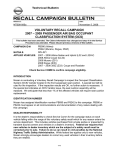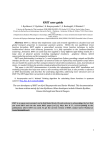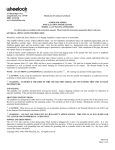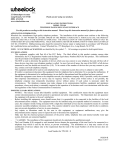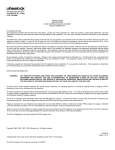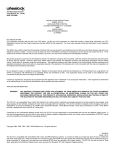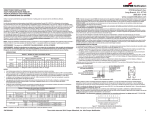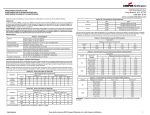Download Wheelock TPI-100 Specifications
Transcript
273 Branchport Avenue Long Branch, N.J. 07740 (732) 222-6880 INSTALLATION INSTRUCTIONS MODEL TPA-60-B/TPA-100-B PAGING AMPLIFIERS GENERAL APPLICATION INFORMATION: Wheelock models TPA-60-B and TPA-100-B Paging Amplifiers are output rated at 60 watts RMS and 100 watts RMS respectively. These amplifiers afford a choice of five different inputs: two low impedance microphone inputs, one telephone paging input, and two high impedance auxiliary inputs. Three input channels allow three of these inputs to be used actively at one time: one microphone input, a choice of a telephone paging input or a second microphone input, and a choice of either one of two auxiliary inputs. Note that the auxiliary input (i.e., background music, tone generator, etc) will automatically be soft muted whenever a telephone page is generated or a microphone is used. After completion of the page, the music will rapidly return to its original level. A built-in limiter circuit (ALC) compensates for the varying voice levels and paging styles of the people who have access to telephone paging or a microphone. The limiter maintains rated output without distortion. The amplifiers feature individual input volume controls, as well as a master volume control, individual treble and bass controls, a low-cut horn protect switch, two input selector switches, an illuminated power on switch, an internal ALC (limiter) ON-OFF switch, an internal mute ON-OFF switch, a peak level indicator, and a line output jack. Both models operate from 120 volts, 60Hz and have a power consumption of 180 watts (TPA-60-B) and 240 watts (TPA100-B). The units have a circuit breaker on the AC line input as well as a thermal breaker for overload protection on the output. The AC circuit breaker is manually resettable. IN THE EVENT THE CIRCUIT BREAKER DOES NOT RESET, HAVE THE TROUBLE INVESTIGATED BY AN AUTHORIZED SERVICE TECHNICIAN OR RETURN UNIT TO THE FACTORY. WARNING: TO REDUCE THE RISK OF FIRE OR ELECTRIC SHOCK, DO NOT EXPOSE THIS UNIT TO RAIN OR MOISTURE. UNPACKING: The amplifier was carefully checked before leaving the factory. Inspect shipping container and unit carefully for indication of improper handling. If the unit has been damaged, make an immediate claim to the carrier. MOUNTING INSTRUCTIONS: The amplifier is provided with a set of universal mounting brackets to facilitate either rack or surface wall mounting. Remove the 8 screws (4 on either side) holding the cover to the chassis. Choose the mounting required (rack or surface wall), and insert screws through the universal mounting bracket and back into the cover/chassis holes as shown in Figures 1 and 2. CAUTION: THESE DEVICES ARE NOT INTENDED FOR USE IN HAZARDOUS LOCATIONS AS DEFINED BY THE NATIONAL ELECTRICAL CODE (NEC) AND BY THE NATIONAL FIRE PROTECTION ASSOCIATION (NFPA). P82423 C Sheet 1 of 10 RACK MOUNTING FIGURE 1. SURFACE WALL MOUNTING For surface mounting, be sure to use hardware suitable for the mounting surface. FIGURE 2. POWER AND GROUNDING: The 120 VAC line cord has a three-prong plug which should be plugged into a three wire grounded electric outlet. It is very important to maintain the amplifier ground for safe and trouble-free operation. If there is no grounded electric outlet, connect a wire from the GND terminal on the OUTPUT terminal strip to a water or steam pipe. P82423 C Sheet 2 of 10 TECHNICAL SPECIFICATIONS: # PARAMETERS 1 POWER OUTPUT @ 1 KHz 2 TOTAL HARMONIC DISTORTION 3 OUTPUTS 4 LINE OUTPUT INPUTS TPA-60-B TPA-100-B 60 WATTS RMS 100 WATTS RMS LESS THAN 2% THD 4 ohms, 8 ohms, 25V, 70V 150 ohm, 1.1VRMS TELEPHONE MIC 1/MIC 2 AUX 1/AUX 2 5 IMPEDANCE 600 ohm 600 ohm 47K ohms 6 SENSITIVITY -20 dBm 1 mV 220 mV 7 FREQ. RESPONSE 300Hz - 4KHz 70Hz - 15KHz 70Hz - 15KHz 8 SIGNAL TO NOISE RATIO 65dB 60dB 75dB 9 TYPE OF INPUT XFMR BALANCED UNBALANCED ISOLATED/BAL OR UNBAL. TEL/MIC 1, MIC 2, AUX 1/AUX 2, INPUT LEVELS, BASS, TREBLE, MASTER VOLUME, TEL/MIC 1 AND AUX 1/AUX 2 SELECTOR SWITCHES, POWER ON/OFF SWITCH, LO-CUT SWITCH, ALC (LIMITER) ON-OFF SWITCH (INTERNAL), AUX MUTE ON-OFF SWITCH (INTERNAL). 10 CONTROLS 11 INDICATORS AMBER OR RED NEON - POWER ON RED LED PEAK LEVEL 12 PROTECTION 13a TREBLE CONTROL AC LINE RESETTABLE CIRCUIT BREAKER AND THERMAL OVERLOAD PROTECTION ON OUTPUT. -10.5 dB TO +10.5 dB @ 12 KHz 13b BASS CONTROL 14 15 LO-CUT SWITCH AUTOMATIC LIMITER FOR PAGING 16 AUTOMATIC MUTE OPERATION 17 REGULATION NO LOAD TO FULL LOAD OUTPUT LESS THAN 2 dB. 18 CONSUMPTION 180 WATTS MAX. 19 SIZE 20 WEIGHT +10.5 dB TO -10.5 dB @ 100 Hz -6 dB @ 250 Hz +/-3 dB OUTPUT LEVEL MAINTAINED WITHOUT CLIPPING, EVEN WHILE EXCEEDING RATED INPUT LEVEL UP TO 20 dB. OUTPUT LEVEL 1 WATT FOR 40 dB MUTING 280 WATTS MAX. 15"W X 11.25"D X 4.125"H (38.1 X 28.6 X 10.1cm) 15lbs. (6.75Kg) 18lbs. (8.1Kg) P82423 C Sheet 3 of 10 INPUT CONNECTIONS (FIGURES 3 & 4) TELEPHONE PAGING INPUT (FIGURE 3): Connect telephone wires to the input screw terminals marked TIP and RING. Set TEL/MIC 1 Switch (on front panel) to TEL position. For Tip and Ring connections to various types of telephone paging access, see Figures 9A, B & C. For Tip and Ring connections to Wheelock Zone Controls, refer to the specific zone control installation instructions. MICROPHONE INPUTS (FIGURE 3): Connect balanced low-impedance microphone wires to the input screw terminals marked LO-Z. The shield must be connected to the GND screw terminals. An unbalanced microphone may be connected to the same screw terminals. However, one of the two LO-Z terminals for that input must be connected to the adjacent screw terminal marked GND. Install a jumper wire, between one LO-Z screw terminal and the GND screw terminal. NOTE: TO AVOID POSSIBLE INTERFERENCE, THE MICROPHONE INPUT CABLE SHOULD BE A SHIELDED CABLE, WITH THE SHIELD CONNECTED TO THE INPUT GND TERMINAL. MIC 2 is a low impedance (LO-Z) microphone input channel. TEL/MIC 1 is a switch selectable telephone paging, or low impedance (LO-Z) microphone input channel. INPUT CONNECTIONS FIGURE 3. AUXILIARY INPUTS (FIGURE 4): To connect an FM tuner, CD player, tape player, tone generator, or any other line level program source (i.e., mic/line mixer) to either the AUX 1 or AUX 2 input jacks on the back panel, use a single conductor shielded cable terminated in a standard RCA type phono plug. AUX 1/AUX 2 is a high impedance (HI-Z) input channel providing a selection of 2 separate inputs. AUX 1/AUX 2 HIGH IMPEDANCE (HI-Z) INPUTS FIGURE 4. P82423 C Sheet 4 of 10 OUTPUT CONNECTIONS (FIGURES 5&6) REFERRING TO FIGURE 5: Connect 2 output wires from the speaker load, to the COM screw terminal and the selected constant voltage terminal, (i.e. 25V or 70V). The constant voltage distribution method facilitates the use of multiple speakers in parallel with a single amplifier. Note that each speaker must have its own 25V or 70V line-matching transformer. Select the wattage tap on the line matching transformer of each speaker, for the power (volume) desired. A 4 ohm or 8 ohm speaker load may be connected to the COM and either the 4 ohm or 8 ohm terminals. NOTE: THE WATTAGE RATING OF THE 4 OHM OR 8 OHM SPEAKER LOAD SHOULD NOT BE EXCEEDED. To minimize power loss in the system cabling, use a wire gauge suitable for the power being distributed and the length of cable. See Wheelock product bulletin # 89-91. NOTE: TO ALLOW FOR FUTURE EXPANSION, AND DISTRIBUTION CABLE LINE LOSS, IT IS RECOMMENDED THAT THE TOTAL SYSTEM WATTAGE SHOULD NOT EXCEED 85% OF THE AMPLIFIER'S RATED OUTPUT (I.E. 51 WATTS FOR THE TPA-60 AND 85 WATTS FOR THE TPA100). THE TOTAL SYSTEM WATTAGE REQUIREMENT IS THE SUMMATION OF THE WATTAGE TAP SELECTIONS OF ALL SYSTEM SPEAKERS AND HORNS. OUTPUT CONNECTIONS FIGURE 5. LINE OUTPUT (FIGURE 6): The LINE OUTPUT jack on the back panel, can be used to cascade amplifiers (including amplified speakers, or Wheelock PRM 150 preamplifiers), or connect (send signal to) a tape recorder. The signal on this output is a line level mix of the amplifier's input channels. Use single conductor shielded cable with standard RCA type phone plugs. LINE OUTPUT FIGURE 6. NOTE: THE LINE OUTPUT SIGNAL IS CONSTANT AND IS UNAFFECTED BY THE AMPLIFIERS MASTER VOLUME, BASS AND TREBLE CONTROLS. P82423 C Sheet 5 of 10 A. CASCADING AMPLIFIERS (FIGURE 7): TPA-60-B and TPA-100-B amplifiers can be cascaded to expand existing systems or to distribute large speaker loads. CASCADING AMPLIFIERS FIGURE 7. B. TO CONNECT A TAPE RECORDER (FIGURE 8): A tape recorder can be connected to record live programs (microphone inputs), or all of the amplifiers activity (all inputs). CONNECTING A TAPE RECORDER FIGURE 8. P82423 C Sheet 6 of 10 TELEPHONE PAGING ACCESS CONNECTIONS AUDIO PAGE PORT FIGURE 9A. CO LINE, CENTREX NUMBER LINE, OR ANALOG STATION EXTENSION PORT (Refere to TPI-100 installation instructions for internal control settings and adjustments.) FIGURE 9B. UNUSED CO LINE/TRUNK PORT OR STAND ALONE TELEPHONE FIGURE 9C. CAUTION: CONNECT ONLY TO PBX INCORPORATING ISOLATION FROM TELECOM NETWORK. ATTENTION: RACCORDER SUELEMENT A UNSYSTEME PBX INDEPENDANT/DU RESEAU DE TELECOMMUNICATION. P82423 C Sheet 7 of 10 OPERATION FIGURE 10. (Front panel controls, switches and indicators.) NOTE: ALL CONTROLS ROTATE CLOCKWISE TO INCREASE AND COUNTERCLOCKWISE TO DECREASE. EXTERNAL CONTROLS AND INDICATORS (FIGURE 10): POWER ON-OFF SWITCH (ILLUMINATED): The light inside the switch will illuminate when the AC cord is plugged into a 120 VAC source and the power switch is pressed to the ON position. (Set at factory in OFF position.) MASTER VOLUME CONTROL: Adjusts the total output level of the amplifier without disturbing the individual settings of the microphone, telephone and auxiliary input volume controls. (Set at factory in minimum position.) TEL/MIC 1 INPUT VOLUME CONTROL: Adjusts the volume of either the TEL (Telephone) paging or MIC 1 input. (Set at factory in the minimum position.) AUX 1/AUX 2 INPUT VOLUME CONTROL: Adjusts the volume of the AUX 1/AUX 2 inputs. (Set at factory in the minimum position.) BASS AND TREBLE CONTROLS: Adjusts bass and treble for optimum tonal balance of the output signal. The amplifier frequency response is flat with the knob indicators pointing straight up (Dot #6). (Set at factory in Dot #6 position.) TEL/MIC 1 SELECTOR SWITCH: Switch to TEL position for telephone paging, or switch to MIC 1 position when using a microphone. (Set at factory in the TEL position.) AUX 1/AUX 2 SELECTOR SWITCH: Switch to either AUX 1 or AUX 2 position, depending upon which of 2 program source inputs are utilized. (Set at factory in AUX 1 position.) HORN PROTECT/LO-CUT SWITCH: This switch is located on the lower right hand side of the rear panel. Turn the switch ON whenever horns are used in the system. This will protect the horn voice coils from damage by filtering out low frequencies inherent in some types of music when played at high power settings. (Set at factory in OFF position.) PEAK LEVEL INDICATOR: Occassional flickering of the LED indicates momentary peak levels, and is a normal operating condition. Steady illumination of the LED is an indication that an overdrive (clipping) condition may exist. If distortion is audible, then lower the appropriate input volume control, and/or the master volume control. P82423 C Sheet 8 of 10 INTERNAL SWITCHES (FIGURE 11): There are two internal switches. These are ALC (limiter) ON-OFF, and MUTE ON-OFF switches. They are accessed by removing the amplifier cover. NOTE: FOR MOST PAGING AND BACKGROUND MUSIC SYSTEM APPLICATIONS, IT IS NOT NECESSARY TO ACCESS THESE SWITCHES. WARNING: TO AVOID THE RISK OF ELECTRIC SHOCK, BE SURE THAT THE AMPLIFIERS AC LINE CORD IS DISCONNECTED FROM THE AC POWER SOURCE BEFORE REMOVING THE COVER. Remove the 8 screws (4 on either side) holding the cover to the chassis. When viewed from the top front of the amplifier, the switches are located on a 4 segment switch block, in the lower left hand section of the power PC Board which is mounted to the chassis base. ALC (LIMITER) AND MUTE ON-OFF SWITCHES FIGURE 11. P82423 C Sheet 9 of 10 ALC (LIMITER) ON-OFF SWITCH: For live program applications, (i.e., house of worship, auditoriums, etc.), it is often desirable to defeat the ALC (limiter) function. This results in more "natural" (wider dynamic range) sound reproduction. Move switch #4 to the right (OFF) position. (Set at factory in the ON position.) MUTE ON-OFF SWITCH: In certain applications (i.e., noise masking, tone signals, etc.), it is often desirable to defeat the auxiliary input mute function. This results in the auxiliary input signal mixing (occurring simultaneously) with telephone paging, or microphone input audio. Move switch #1 to the right (OFF) position. (Set at factory in the ON position.) NOTE: SWITCH POSITIONS #2 AND #3 ARE NOT USED. (SET AT FACTORY IN "ON" POSITION.) MAINTENANCE: CAUTION: THERE ARE NO USER-REPLACEABLE PARTS WITHIN THE UNIT. HAVE ALL INTERNAL SERVICING DONE BY A QUALIFIED TECHNICIAN. LIMITED WARRANTY: Refer to Wheelock's Terms and Conditions of sale. WARNING - ANY MATERIAL EXTRAPOLATED FROM THIS DOCUMENT OR FROM WHEELOCK MANUALS OR OTHER DOCUMENTS DESCRIBING THE PRODUCT FOR USE IN PROMOTIONAL OR ADVERTISING CLAIMS, OR FOR ANY OTHER USE, INCLUDING DESCRIPTION OF THE PRODUCT'S APPLICATION, OPERATION, INSTALLATION AND TESTING IS USED AT THE SOLE RISK OF THE USER AND WHEELOCK WILL NOT HAVE ANY LIABILITY FOR SUCH USE. 4/93 P82423 C Sheet 10 of 10










